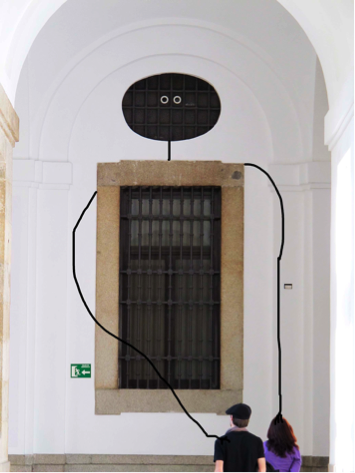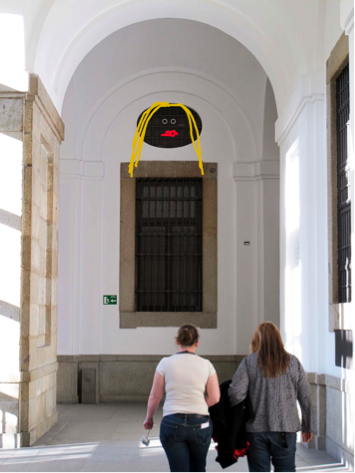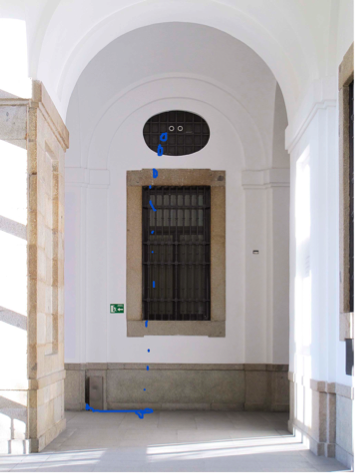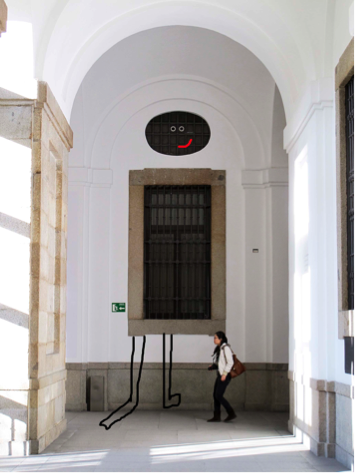Becoming Undone
I was constipated. It was big and stifling and getting in the way of things. No matter how long I sat there, and how many web pages I had tabbed open in the process, nothing was coming out. But it wasn’t until someone gave it a name that I could see it. 'You’ve got writer’s block.' And there it was: a condition for my frustrating symptoms. The block didn’t budge but it now had presence. It was My Block: a big brown lump that rose up out of my laptop like a genie. While this didn’t make it any less exasperating, it nonetheless felt like company where before I had felt alone.
This article is the one I was trying to write. Despite the lack of output, there were ideas and I was interested in the meaning of the keyboard action Control + Z as a code used to undo a previous action. An act of erasure that nonetheless is an act. Two paragraphs were painfully deposited onto the blank screen. To undo is to create: the opening sentence. What followed was overdone and overwritten and so I won’t repeat it here, but in summary, it was an attempt to offer a meditation on the ‘redone’ as a form of mime—as if it were possible to rehearse the present. Thinking about this reversal of an action in order to replace it with another, I wrote something about undoing as being a performance of the present. It does not stop time but it does make for an apparent pause, one that allows for a closer inspection of a moment and in doing so, renders it visible and in its playback, it becomes art.
Now I’m not quite sure exactly how I was planning to justify this art-via-playback assertion and thought that a reference to Deleuze’s moving horizon along which he makes, remakes and unmakes his concepts might need to be included (Difference and Repetition, xxi). But really, what I wanted to invoke was Camus’ understanding of the place of art as marking ‘both the death of an experience and its multiplication’ (Myth of Sysiphys, 87). It is a kind of life after death, if indeed we are willing to accept the animation of an avatar.
Freud’s das Ungeschehenmachen uncomfortably trudged its way into paragraph two. This was the term he used to describe the defence mechanism that incorporates a conscious ‘un-happening’ whereby an undesired action is not reversed, but repeated in a different manner so it is as if neither act took place. Undoing is a symbolic act for Freud: 'it is, as it were, negative magic, and endeavours, by means of motor symbolism, to blow away not merely the consequences of some event (or experience or impression) but the event itself’ (Psychopathology, 275). Freud’s description of the symbolic act resonated here because it highlighted the difference between the visibility of the Control + Z undo in contrast with the more permanent, instant and forgettable death by Delete .
And so I rejected the paragraphs, returning to the blank screen. Perhaps my contribution to this online journal and exhibition space didn’t need to include any text at all, only images. My Block raised an eyebrow. There was that series of four photographs I had taken at the Museo Reina Sofia in Madrid: four views of a hallway showing a rectangular grill on the far wall with an oval grill above it that was embedded with two round circles bearing a strong resemblance to a pair of eyeballs. I had later digitally drawn over the images in order to animate this apparent floating head and body living in the museum’s walls. Maybe this was my way around the Block and these pictures could say something to Ctrl-Z’s questioning of the implications of new media with regards to ‘old’ media.
|
Clingy Sofia |
Sister Sofia |
|
Sad Sofia |
Bad Sofia |
It was a bit of a stretch.
Tab #34 on Overcoming Writer’s Block suggested that perhaps I needed to leave my East End flat and try to write elsewhere. Hoping that my Block was site-specific, I started upon the voyage out to Bloomsbury and found a café with the requisite Wi-Fi, outward seating and lack of frappuccino lattes. There were a number of laptop gazers about and I felt in good company, my Block seemingly absent. Instead, it was Derrida who had joined me on the excursion, having just arrived that morning from a secondhand bookseller in Florida.
A few weeks earlier, pre-Block, I had been thinking about possible titles for the book I have yet to write, in the hope that they might guide me to its contents. I’ve been doing a lot of painting, oils on big canvases—a little unusual for someone who has primarily been making images with a flatbed scanner for the past ten years. What had always attracted me to the scanner was its ability to make touch visible, to squash and to see up close, to be crude, blatant, and gravely literal. But having scanned for some time, it was beginning to feel more like cultivated performance than an unrefined show. Despite many years at art school, I have never attended a life drawing class and so there is a certain lack of communication between my hand and brain that is very enjoyable. It’s a little like being able to see a thought and feels more honest and barefaced than the familiar glass stage of the flatbed. Thinking that perhaps I could write something about ‘The Truth in Painting’, it took a few weeks for me to Google the phrase and thereby discover that Derrida had already written the book in 1987.
The Truth in Painting sat beside me in the café window, but it was a different Derrida that was recalled. The blank screen now had Mystic Writing Pad as its first line. This toy that was the focus of a short paper on memory written by Freud in 1924 seemed pertinent because of its description of the traces left behind after a process of doing and undoing. The Mystic Writing Pad, a little device in existence in the early part of the twentieth century, was made up of a block of wax that was hinged with a sheet of translucent wax paper covered by a celluloid sheath. When a stylus was pressed against the plastic membrane the ensuing marks recorded were clearly visible without the need of chalk or ink. When the two thin upper layers were raised, the inscription was ‘magically’ erased, yet the wax block still retained evidence of the activities performed above. In certain light, the residue of previous etchings remained visible on the waxy surface—obscured only by successive markings on the outer surfaces.
Freud used this ‘Wunderblock’ as a means to illustrate his theories of the perceptual apparatus of the mind. This metaphor for inscription calls to mind Plato’s description of memory as a wax tablet imprinted with an impression of the thing to be remembered (Whitehead, Memory, 15). For Plato, this knowledge would remain for only as long as the block could retain its imprint. If the mark was to fade or be erased, the object of memory was forgotten. The outlines left behind on Freud’s wax block however, represented indelible and unalterable mnemonic traces preserved in the unconscious. The double covering sheets of the Mystic Pad illustrated both the ego’s protective shield against external stimuli and the ability to record and erase, a process of doing and undoing that works to ensure an unlimited capacity for reception.
The conclusion to the story of the Mystic Writing Pad describes how the toy could be maneuvered in order to best resemble the workings of the psyche. The instructions called for a two-handed operation, one that writes while the other periodically raises the covering sheets. Freud noted that this discontinuous act of writing and disappearance ‘lies at the bottom of the origin of the concept of time’ (Whitehead, Memory, 434). According to Derrida, ‘time is the economy of a system of writing’ ('Freud and the Scene of Writing', 284). In Archive Fever: A Freudian Impression, he refers to Freud’s model as a ‘prosthesis of the inside’ (19). Despite being bound to life, as pure representation Freud’s metaphor is condemned to be a dead machine and one without depth because it cannot run by itself. For Derrida, ‘life as depth belongs only to the wax of psychical memory’ ('Freud and the Scene of Writing', 286).
The structural makeup of the Mystic Writing Pad is not dissimilar to the flatbed scanner. Both are machines that comprise a transparent plane onto which pressure is applied in order to record the memory of presence. As with the Writing Pad’s plastic sheath, the scanner’s glass is the essential mediator that creates a required proximity in order for the impression to be remembered. The application of both devices involves the act of raising an external covering that affects an expunction of any residual impressions. In the case of the flatbed, the lifting of the lid will result in a relief of the force generated at the juncture of object and glass.
The scanner and the Writing Pad are devices capable of multiple recordings on the same surface. The mysticism of the flatbed lies in its capacity to transform intimate contact into a codified sum of its parts. The time of the initial act can never be repeated or undone, but in its digital transcription it can be endlessly reproduced. It too is a dead machine, but one with the capacity to reproduce the traces of an encounter, translated into an image. The copy will perform the memory of the act upon each subsequent viewing, unless of course the file is deleted. But even so, erasure is now no longer a finite act.
Derrida had done my head in and my coffee was long gone so I decided to take a walk to clear my thoughts. Heading down Lambs Conduit Street, I pulled out my iPhone to see where I was on the map. It was sometime in the early afternoon and it was raining so the hood on my jacket was pulled up which meant that I didn’t see the guy on the bicycle riding alongside me. Not until I felt him. Or rather, I felt my phone being plucked from my right hand. At first I had thought it was someone playing a joke, but then remembered being alone. I ran after him shouting ‘No, No, Stop Him’. It all happened very quickly but in recollection, it is one of those moments that feel stretched. I remember feeling slightly embarrassed about screaming so loudly in such a quiet area of London. My Block had forced me out of home and into the path of a pedalling thief.
The new phone arrived twenty-four hours later. I plugged it in and ‘restored from a backup’. It looked just the same but in a white frame, even remembering the six web pages that had been left open in Safari. It was like nothing had ever happened but I couldn’t stop reliving that feeling of the phone disappearing from my hand. In the seconds it took to comprehend the event, I could still feel its weight and shape, like a phantom.
Things don’t die if we save them. Control + S is a knowing command, archiving a particular moment in time in the life of a file and recording it to memory. The time between saves is vulnerable to loss. It is here, awaiting the next judgment that deems the form worth reserving, that the traces and actions, the doings and un-doings are vulnerable to erasure. The last save is no longer final. Backup utilities such as Time Machine allow users to literally go back to a specified time and return to a previous incarnation. As with Freud’s neurotics, this does not result in an undoing of time itself, but the index of incremental backups does allow for a reappearance of the past, untouched by the future acts that succeeded it. The memory of the hard drive is rewound, but only under the direction of the operator of the machine who mourns in a nostalgic present.
The words are picking up as the pressure between the Block and me reverses. It is enough for me to fear their disappearance so that I’m currently sending as well as saving the file. My inbox is my Tardis, though ‘sending’ is no longer the requisite method for dissemination. As evidenced in recent terrorist activities, simply obtaining access is now just as significant as a direct transmission of communication. Referred to as the Dead Drop Box, an email account is set up and its password circulated to those involved. All communication is then made via the draft mailbox folder. Members log in, reading and deleting draft messages. The secret correspondence takes place without actually sending an email. More like a thought than a memory, the draft folder becomes a holding bay for mind readers. All new inscriptions are laid atop of the old in a simultaneous act of gleaning, effacing and blind revision.
Writer’s block causes an inability to produce new work. It is an obstacle, but not necessarily a fatal one. Death is fatal, but it does not automatically result in an inability to produce new work, as was demonstrated in Tupac’s recent performance at the Coachella music festival. Despite having been murdered sixteen years ago, the rapper was seemingly reincarnated on the stage, but this was no rerun from the archive. Initially referred to as the ‘Tupac hologram,’ the moving image was a virtual rendition that presented a synthetic digital surrogate via an illusory stagecraft technique first identified in the nineteenth century.
This illusion creates a spectre that is known as ‘Pepper’s Ghost,’ a result of the projection of a two-dimensional image onto a sheet of glass or plastic. The transparent yet reflective surface is angled so that the source of its reflection can remain concealed in a hidden room. The three-dimensional apparition perceived on the transparent sheet is a refracted mirage that will be retained so long as the plastic is not exposed by other lighting. Unlike the physical impressions embedded upon the Mystic Writing Pad, the visibility of form in Pepper’s Ghost is dependent on an outward projection. In the case of Tupac’s resurrection, the illusion was created by the reflected projection of light from a mirror to a screen. The apparatus resembled the star, like Freud’s Mystic Writing Pad resembled the human psyche. However the reflected projection was a posthumous echo, a choreographed staging of the subject. This was a live performance by the dead. It ended with a bang: an explosive disintegration of the ghostly figure on stage, forever redoing the death that had been undone.
References
Camus, Albert. 'Absurd Creation', in The Myth of Sisyphus, trans. Justin O'Brien. Middlesex: Penguin, 1977, pp. 86-106.
Deleuze, Gilles. Difference and Repetition, trans. Paul Patton. New York: Columbia University Press, 1994.
Derrida, Jacques. Archive Fever: A Freudian Impression, trans. Eric Prenowitz. Chicago and London: University of Chicago Press, 1998.
Derrida, Jacques. 'Freud and the Scene of Writing', in Writing and Difference, trans. Alan Bass. London: Routledge, 2001, pp. 196-231.
Freud, Sigmund. 'A Note Upon the "Mystic Writing Pad"’, in On Metapsychology, trans. James Strachey, ed. Angela Richards. Middlesex: Penguin, 1993, pp. 427-34.
Freud, Sigmund. On Psychopathology, trans. James Strachey, ed. Angela Richards. Middlesex: Penguin, 1987.
Whitehead, Anne. Memory. London: Routledge, 2009.
Ctrl-Z: New Media Philosophy
ISSN 2200-8616








